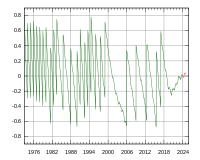Wikipedia:Featured picture candidates/Leapsecond.ut1-utc
Leapsecond.ut1-utc[edit]

Vertical segments correspond to leap seconds. Red part of graph was prediction (future values) at the time the file was made.
Graph showing the difference between UTC (based on an atomic clock with leap seconds) and UT1 (based on the movement of the Earth). This graph illustrates the effect of leap seconds, along with why there have been so few leap seconds in the past several years.
Used in Leap second, Coordinated Universal Time and DUT1.
- Nominate and support. - Billpg 16:04, 14 October 2006 (UTC)
- Weak oppose. It's in SVG, looks good, and demonstrates the concept, but I don't think it's the best Wikipedia has to offer. I also don't like the very short "predicted" segment at the end. It should either have a relatively long predicted segment, or none at all. This type of graph will have to be updated every year or so to remain accurate. --Tewy 17:40, 14 October 2006 (UTC)
- Oppose. Yeah I guess it's encyclopedic, but it's certainly not pleasing to the eye, or at least mine. Robert 23:44, 14 October 2006 (UTC)
- Comment As an idea for a different graph, I'd like to see a cumulative chart of measured deviation from 0 leapseconds, with a second jagged line representing the official UTC time (including the effects of leapseconds). This one just looks like a jittery line, and makes it hard to grasp the actual variance over time. Night Gyr (talk/Oy) 09:01, 16 October 2006 (UTC)
- Oppose. Ordinary science graph. The maximum value of the ordinate axis should be 1.0, not 0.8. -- Alvesgaspar 20:42, 17 October 2006 (UTC)
- Just out of curiosity, what's wrong with the value 0.8? - Adrian Pingstone 07:52, 20 October 2006 (UTC)
- Nothing really wrong as a matter of fact. But it is a common practise in scientific graphs to use "round" numbers whenever possible or adequate, with the aim of facilitating reading and interpretation. It is also a common practise to extend the ordinate axis a little beyond the extreme values, I believe for aesthetical reasons. - Alvesgaspar 10:30, 20 October 2006 (UTC)
- Leap seconds are intended so that the difference never goes beyond +/- 0.9 seconds. --Billpg 12:57, 20 October 2006 (UTC)
- I apologize if this is in the wrong place or I'm doing this wrong, I'm new to editing...But is there a possibility someone could point me to a graph of all the data since 73? I'd be curious to see, in a plain and simple graph, if there are any patterns or trends there. --Curious 10:36, 01 April 2007 (EST)
